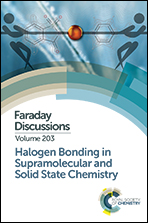Do halogen bonds dictate the packing preferences in solid solutions?†
Abstract
The isomeric compounds, 4-bromo-2-chloro benzoic acid (4Br) and 2-bromo-4-chlorobenzoic acid (2Br), crystallize in entirely different space groups, P21/n and P![[1 with combining macron]](https://www.rsc.org/images/entities/char_0031_0304.gif) respectively. Both structures are stabilized by a strong O–H⋯O hydrogen bonds generating a carboxylic acid dimer along with an unusual triangular halogen bonded motif in the former and a well-defined halogen bond in the latter. Charge density analysis establishes the nature of halogen bonds by bringing out significant changes in the packing features of the two structures as well as the quantification of the interaction energies involved in the formation of the motifs. Cocrystallization efforts lead to the formation of solid solutions of varied stoichiometric ratios among the two entirely different crystalline forms, a feature which is observed for the first time, and depends on the nature of the halogen bonds. Despite the significant variations in the charge density distribution in intermolecular space, the triangular motif, with two type II Br⋯Cl and Cl⋯Br and one type I Br⋯Br contact in the structure of 4Br dictates the packing preferences in the solid solution as established by accurate single crystal diffraction studies supported by cognate powder diffraction analysis (PXRD) and differential scanning calorimetric (DSC) studies. A systematic study of the solid solution by varying the stoichiometric ratios establishes the hierarchy in halogen bonded motifs and consequently its directional influence to form the resultant supramolecular assembly.
respectively. Both structures are stabilized by a strong O–H⋯O hydrogen bonds generating a carboxylic acid dimer along with an unusual triangular halogen bonded motif in the former and a well-defined halogen bond in the latter. Charge density analysis establishes the nature of halogen bonds by bringing out significant changes in the packing features of the two structures as well as the quantification of the interaction energies involved in the formation of the motifs. Cocrystallization efforts lead to the formation of solid solutions of varied stoichiometric ratios among the two entirely different crystalline forms, a feature which is observed for the first time, and depends on the nature of the halogen bonds. Despite the significant variations in the charge density distribution in intermolecular space, the triangular motif, with two type II Br⋯Cl and Cl⋯Br and one type I Br⋯Br contact in the structure of 4Br dictates the packing preferences in the solid solution as established by accurate single crystal diffraction studies supported by cognate powder diffraction analysis (PXRD) and differential scanning calorimetric (DSC) studies. A systematic study of the solid solution by varying the stoichiometric ratios establishes the hierarchy in halogen bonded motifs and consequently its directional influence to form the resultant supramolecular assembly.
- This article is part of the themed collection: Halogen Bonding in Supramolecular and Solid State Chemistry


 Please wait while we load your content...
Please wait while we load your content...